USS Wichita (1937)
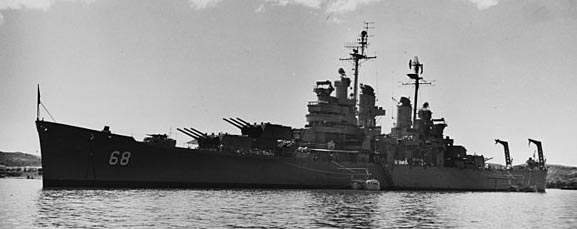
The Wichita directly inspired the wartime Baltimore class design
Design History
Secretary of the Navy, Curtis D. Wilbur wanted a new construction program for light and heavy cruisers and obtained the Cruiser Act of 1929, authorizing five new heavy cruisers (Under the Washington Treaties definition of a CA) The first four were ordered in 1931-33, of the New Orleans class, and the last was USS Wichita ordered in 1934, as permitted under the London Naval Treaty in 1930 as the US was capped to 18 heavy cruisers of 10,000 long tons. The British reached that limit with their County class and the two York class, dropping the Surrey class because of the same treaty.
Wichita was originally intended as an improved New Orleans class, and the design went through several waves of deep redesigns before construction. In the end, she was modelled on the contemporary Brooklyn class “light” cruisers instead. Superficially, she looked like a Brooklyn with heavy artillery. But in reality, the ship’s hull was given higher freeboard, better stability, and better range.

The Brooklyn class as built, general appearance (author’s illustration)
The secondary battery (eight single 5-inch guns) was standard for ships of her type but was arranged in such a way as to give them the best fields of fire possible. Also, the main battery was standardized since the Northampton’s triple turrets benefited from a brand new turret design, making the sum of previous problems and fixes detected on earlier turret designs. As the last heavy cruiser, USS Wichita was conceived as the pinnacle of the genre, a provision for new series in case of war. In the end, that’s exactly what happened: Wichita is considered in the lineage and the direct forerunner of the wartime Baltimore class, freed from all limitations.
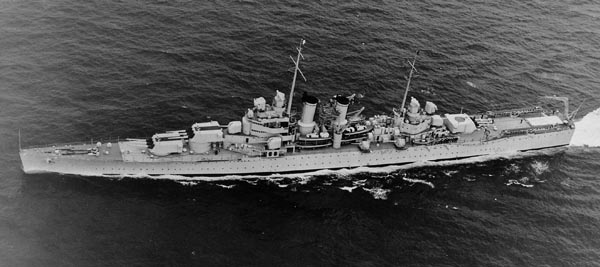
USS Wichita May 1940
Design
General characteristics
Wichita was 600 feet (182.9 m) long at the waterline and 608 ft 4 in (185.42 m) overall, versus 185 m or (606 feet) for the Brooklyn, 61 ft 9 in (18.82 m) in beam versus (19 m (62 feets)), and 23 ft 9 in (7.24 m) draught versus 7 m (23 feet), on the Brooklyn. She, therefore, was shorter and nimbler, but with a higher draft. The hull was therefore certainly not the same despite an overall similar appearance. Both ships had indeed a squarish stem with the hangar and catapult at the rear, as well as two cylindrical raked funnels placed right after the main bridge. The latter comprised two four levels. Two main tubular masts, also raked, were placed exactly like for the Brooklyns.
However, USS Wichita displaced 10,589 long tons (10,759 t) standard and 13,015 long tons (13,224 t) full loaded and combat ready, versus 9,767 long tons standard and 12,207 long tons fully loaded, so despite her reduced dimensions she was actually heavier. One explanation was the larger and deeper ammunition wells and barbettes for the main turrets and their heavier weight to be compensated. A clear focus was placed on stability. Her crew comprised 929 officers and enlisted men.
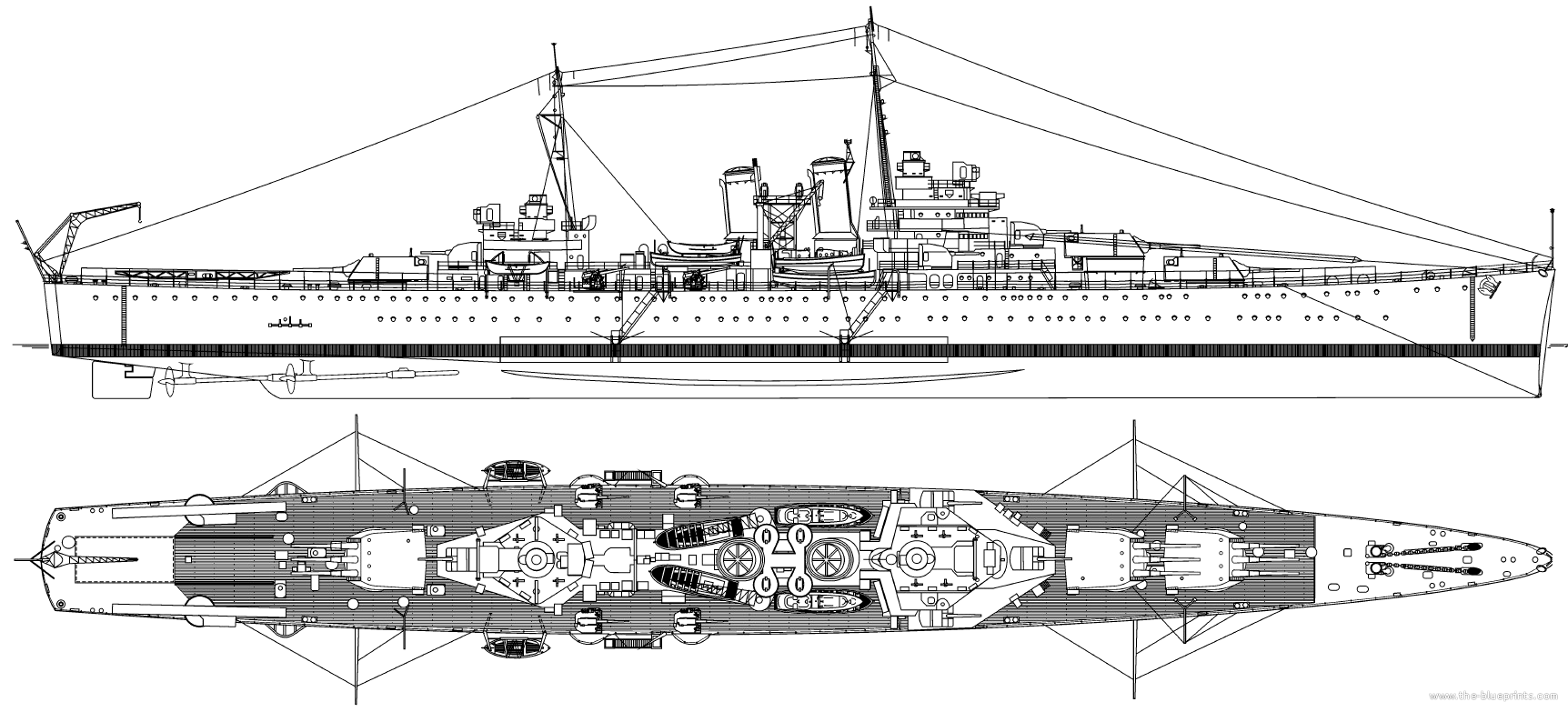
USS Wichita general appearance in 1940. Note the portholes.
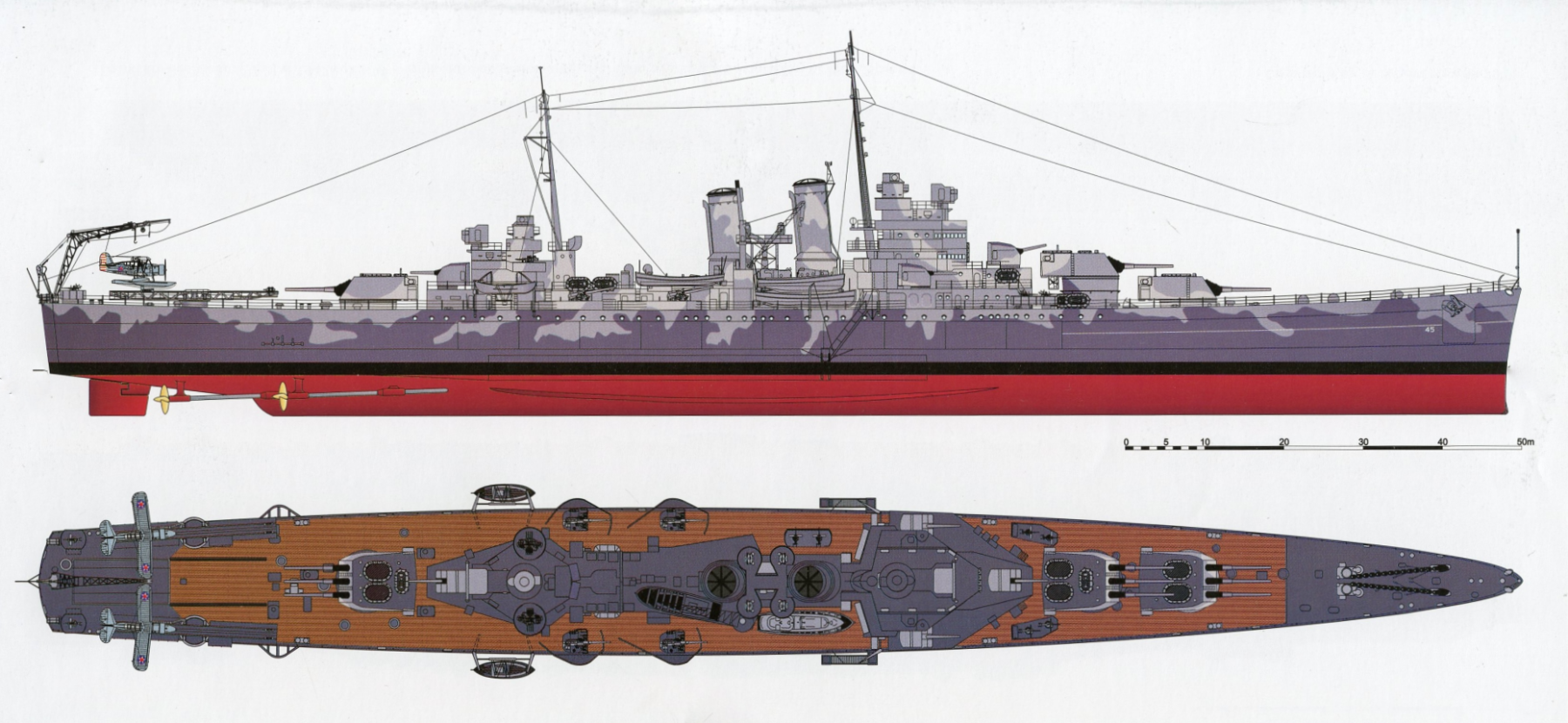
In between she was camouflaged in 1942 with the typical wavy pattern of the time.
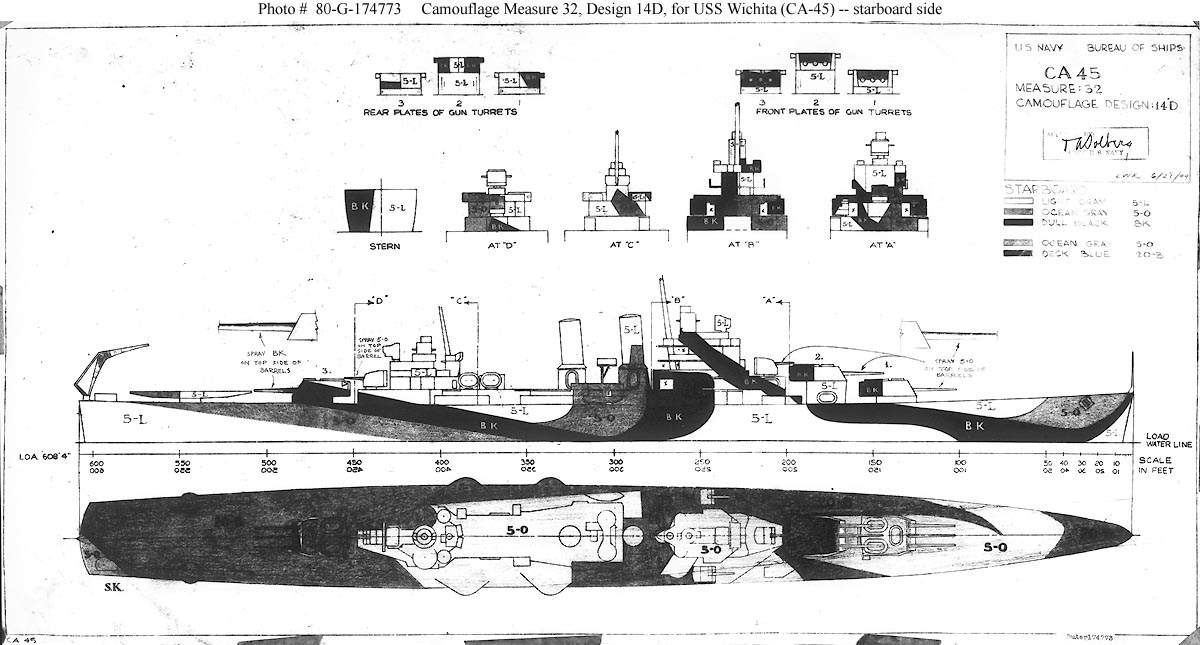
Camouflage measure MS-32, wavy pattern three tones, planned for 1944 but never applied
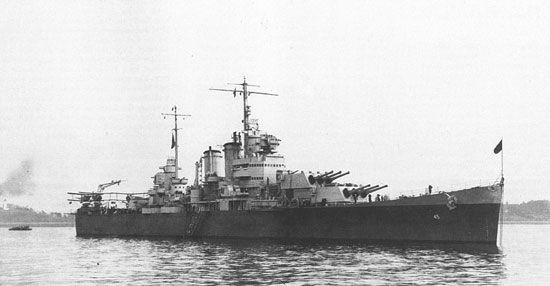
USS Wichita general appearance in 1945.
Powerplant
Wichita was propelled by four shafts which were activated by four Parsons steam turbines and fed by eight Babcock & Wilcox oil-fired water-tube boilers. The powerplant was rated at 100,000 shaft horsepower (75,000 kW). Her top speed was 33 knots (61 km/h; 38 mph). Again, compared to the contemporary Brooklyn, this was about the same powerplant, but the latter was slightly slower, at 32.5 knots (60.2 km/h; 37.4 mph), in part due to the slightly narrower hull and better length-to-width ratio.
In regards to her cruising range, USS Wichita carried 1,323 to 1,984 long tons (1,344 to 2,016 t) of fuel oil. This allowed them a range of 10,000 nautical miles (19,000 km; 12,000 mi) at 15 kn (28 km/h; 17 mph), the same figures as the Brooklyns.
USS Wichita in Iceland, 1942 – src Reddit
Armour
Her hull protection at the waterline comprised of an armored belt made of Class A hardened steel plates 6.4 in (160 mm) thick amidships, reduced to 4 in (100 mm) on both ends. It was backed by a .63 in (16 mm) specially treated steel plating. Class A steel was an improvement on the Class B plates of previous cruisers. Indeed, heavy cruiser protection was to suffice to defeat an 8-inch round fired from 10,000 yards (9,100 m). Class B armor was only capable of doing so at 16,400 yd (15,000 m). In addition, USS Wichita had a single armoured deck over her machinery and ammunition storage, made of a layer of 2.25 in (57 mm) thick plating immune to 8-inch rounds within 22,000 yd (20,000 m). The conning tower was walled by 6 in (152 mm) plates and topped by a 2.25-inch thick roof. The main turrets had faces 8 in (203 mm) thick, 3.75 in (95 mm) sides, and back protected by 1.5 in (38 mm). The turret roof was 2.75 in (70 mm) thick. Their barbettes had walls 7 in (180 mm) thick. Compared to this, the Brooklyn’s protection was significantly lighter: The belt was ranging from 2in (51 mm) to 5 in (127 mm) while the turret’s faces were protected by 6 in (152 mm), and the CT had 5 in walls (127 mm), while the armored deck was also thinner at 2in (40 mm). This protection was meant to defeat 6-in rounds.
Armament
Wichita’s main artillery
Wichita’s main artillery comprised of nine 8-inch/55 Mark 12 guns. They were mounted in three triple turrets, two superfiring forward, and one aft. These Mark 12 models fired a 335-pound (152 kg) shell at 2,500 feet per second (760 m/s). They could elevate to 41 degrees, allowing them a maximum range of 30,050 yd (27,480 m). The average rate of fire of these guns was one shot every 15 seconds (4 rpm). The space between the guns not only allowed individual elevation and firing but reduced shell dispersion. Both the range and hitting power of these guns were superior to the 6-in, limited to 26,100 yards (23,866 m), but the Brooklyns could fire two volleys for one of the Wichita. Their 6-in/47 caliber Mark 16 was indeed able to deliver 10 rpm in sustained fire, a total of 150 rpm.
To utilize her long-range guns to their fullest, and do recon well beyond the range of radar, the Wichita could launch a small squadron of four seaplanes of the Vought OS2U Kingfisher type (likely). They were launched from aircraft catapults located on the sides of the poop deck aft, lifted by an axial crane at the stern. They were usually mounted on the catapults but the hangar was large enough to accommodate all four and was fitted with a repairs and maintenance workshop.
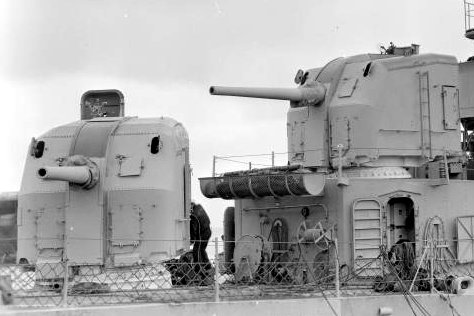
Secondary battery:
USS Wichita was the first USN ship armed with the new 5-inch/38 Mark 12 dual-purpose artillery. These were eight, all in single mounts, half mounted in enclosed Mark 30 high-angle turrets similar to those of destroyers like the Fletcher class (unlike the Brooklyns) while four remained in open mounts. The guns’ disposition was different from the Brooklyns as well: To maximize their arc of fire, two of the enclosed turrets were placed on superfiring positions fore and aft, and the two remaining were abreast the bridge also on raised platforms. The remaining four open mounts were placed like the Brooklyns, on the deck, abreast the rear boat deck between the after bridge and funnels.
These 5-in guns fired a 55 lb (25 kg) shell at 20 rounds per minute with a 2,600 ft/s (790 m/s) muzzle velocity. For AA fire, their ceiling was 37,200 ft (11,300 m) at an 85° angle, whereas they could engage surface targets distant of 18,200 yds (16,600 m) at 45 degrees. Beyond this, their fire was inaccurate. And that was it. There were no lighter AA guns, even a 28 mm “Chicago Piano” or 0.5 cal, though she did carry browning models for close-range defense.
Anti-aircraft upgrades
During the war, especially towards 1944, sixteen Bofors 40 mm guns were added to the ship, four in quadruple mounts, and eight in dual mounts. The first were placed on elevated platforms on either side of the superstructures abreast the mainmast and foremast, while the twin mounts were located on either side of the forward superfiring 5-in gun, behind “B” turret, and the remaining two were located right at the stern, to gain the best arc of fire possible.
She received eighteen Oerlikon 20 mm in single mounts, which were also mounted wherever space was available, mostly on the deck, two aft, between the aft quad Bofors platform and 5-in, four in a “balcony”, platform abreast the two funnels. Two more were mounted abreast the bridge also on deck, and two forward at the bow deck. The 40 mm Bofors ceiling was 22,800 ft (6,900 m) at 90° and could fire around 160 rounds per minute, largely depending on the skill of the loaders. The 20 mm had a higher, 465–480 rpm rate of fire due to the gun being belt-fed. They could reach a plane 10,000 ft (3,000 m) high, but their main purpose was as last-ditch defense, at very close range. In August 1945, many specific fire control systems were added for these, notably the ubiquitous Mark 34 model for fire control and the Mark 13 and Mark 28 FCS radars.
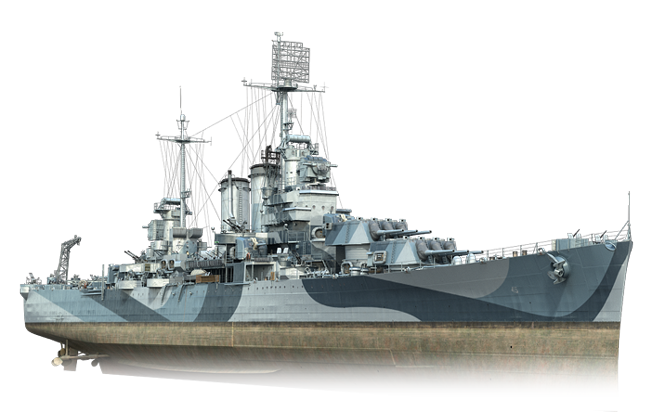
Wow’s rendition of the Wichita, with the never applied camouflage.
Specifications 1939 |
|
| Dimensions | 608 ft 4 in x 61 ft 9 in x 23 ft 9 in (185,42 x 18.88 x 7.24m) |
| Displacement | 10,589 long tons (10,759 t) Full load: 13,015 long tons (13,224 t) |
| Crew | 929 |
| Propulsion | 4 shafts Parsons geared turbines, 8 Babcock & Wilcox boilers, 100,000 shp (75,000 kW) |
| Speed | 33 knots (61 km/h; 38 mph) |
| Range | 10,000 nmi (19,000 km; 12,000 mi) at 15 knots (28 km/h; 17 mph) |
| Armament | 3×3 8 in (203 mm)/55, 8 x 5 in (127 mm)/38, 4 floatplanes |
| Armor | Belt 6.4in (160 mm), turrets 8 in (203 mm), CT 6 in (150 mm), deck 2.25 in (57 mm) |
Src/Read More
Conway’s All the World’s Fighting Ships, 1922–1946
www.history.navy.mil/content/history/nhhc/search.html?q=%22%28CA-45%29%22&docType=photograph
Campbell, John (1985). Naval Weapons of World War II. Conways
Cressman, Robert (2000). The Official Chronology of the U.S. Navy in World War II.
Garfield, Brian (1995). The Thousand-Mile War: World War II in Alaska and the Aleutians.
Hammond, James W. (2001). The Treaty Navy: The Story of the US Naval Service Between the World Wars.
O’Hara, Vincent P. (2007). The U.S. Navy Against the Axis: Surface Combat, 1941–1945.
Rohwer, Jürgen (2005). Chronology of the War at Sea, 1939–1945: The Naval History of World War Two.
Sloan, Bill (2008). The Ultimate Battle: Okinawa 1945—The Last Epic Struggle of World War II.
Terzibaschitsch, Stefan (1984). Cruisers of the US Navy 1922–1962.
Tomblin, Barbara (2004). With Utmost Spirit: Allied Naval Operations in the Mediterranean, 1942–1945.
USS-Wichita Warship-Pictorial
The USS Wichita in action
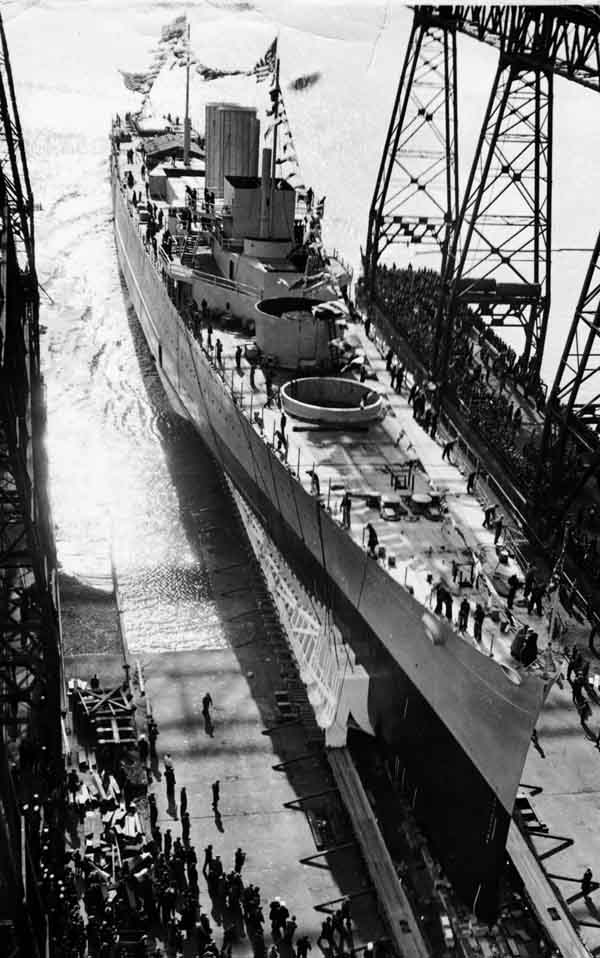
Launch of the Wichita in November 1937 at Philadelphia NyD: Scr Navsource
USS Wichita was laid down at the Philadelphia Naval Shipyard on the 28th of October 1935, to be launched on 16 November 1937. Completion came in February 1938, and at that time, she was so close to the 10,000-ton limit that it was decided to complete her with only two of her eight 5-in guns. Later, this was normalized, and she received all expected 5-inch guns, but she was found to be top-heavy. 200.4 long tons (203.6 t) of pig iron were welded into her bottom and she was commissioned on 16 February 1939, one year after her completion, under command of Thaddeus A. Thomson.
Training on the east coast
For her first service trip, she departed Philadelphia for Houston, Texas, arriving on 20 April 1939 for a memorial service at the San Jacinto Battle Monument. She then left for her first shakedown cruise, visiting the Virgin Islands, Cuba, and the Bahamas. She was back to Philadelphia for modifications and maintenance, and on 25 September, she joined Cruiser Division 7, Atlantic Squadron at Hampton Roads. Her first neutrality patrol started on 4 October, as the war raged in Europe.
She spent some time in drydock in maintenance at the Norfolk Navy Yard until 1 December, departing for Guantanamo Bay (Cuba), to the Caribbean Patrol, joining with USS Vincennes, 5 destroyers, and two Navy patrol squadrons. For three months, she partook in training and patrols in the Caribbean until February 1940, before returning to Norfolk and training until May 1940.
In June she joined up with USS Quincy to make a goodwill cruise to South America, hosting Rear Admiral Andrew C. Pickens, Cruiser Division 7’s commander. The cruisers stopped at Rio de Janeiro, Santos, Buenos Aires, and Montevideo, and were back in Norfolk by September 1940. For the next three months, USS Wichita trained the Naval Reserve midshipmen, making gunnery exercises off the Virginia capes, and in January 1941, joined Guantanamo for fleet maneuvers in the Caribbean, covering a mock landing at Puerto Rico. On 23 March she was back for maintenance at the New York Navy Yard until 6 April, where she sailed to Bermuda to escort USS Ranger and cruiser USS Tuscaloosa for a North Atlantic patrol up to the coast of Ireland.
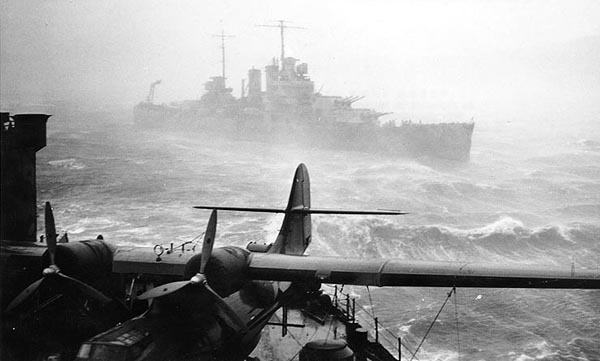
USS Wichita during a winter storm off Iceland, January 1942
Icelandic operations (Summer 1940)
Back to the New York Navy Yard in May 1940, she stayed in drydock until 2 July, after which she departed for Newport, Rhode Island. On 27 July she sailed to Iceland (joining Task Force 16) for Operation Indigo II, Iceland’s occupation by US troops. On 6 August she was in Reykjavik, escorting the carrier Wasp and battleship Mississippi. TF16 landed troops and a fighter Sqn after which the force was back home on 20 August. USS Wichita would make another trip to Iceland in September 1940.
However, at that time, the battle of the Atlantic was in full swing and a state of “quasi-war” existed with Germany as many US Ships did not hesitate to fire on and sink U-Boats in their territorial waters and escort ways. USS Wichita, therefore, was soon assigned to TG 7.5 patrolling Icelandic waters and did this until December 1941. The day after Pearl Harbor, USS Wichita was at anchor in Hvalfjörður, and she left on 5 January 1942 for patrolling the Denmark Strait, before returning to Hvalfjörður. During her next sortie, she was caught on 15 January in a powerful winter storm with winds of 80 knots, and gusts up to 100 knots. She was damaged after colliding with the freighter West Nohno and British trawler Ebor Wyke and later ran aground off Hrafneyri.
Her crew evaluated the hull and saw she had only suffered minor damage and leaks resulting from the grounding. After temporary repairs, she sailed to the New York Navy Yard in February, and her repairs lasted until 26 February. She made a training cruise off Maine in March 1942, and on the 26th, she was assigned to Task Force 39, assisting the Royal Navy.
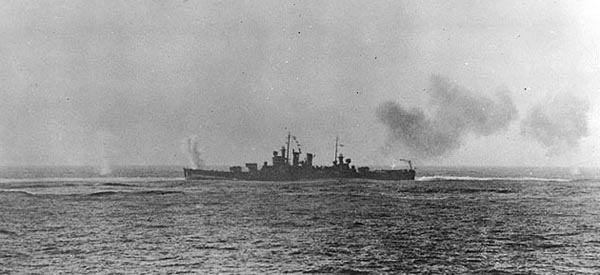
USS Wichita at Casablanca, 8 November 1942, Operation Torch
North Atlantic operations (April-June 1941)
Wichita was based at the British Home Fleet base, Scapa Flow. TF 39 (Rear Admiral John W. Wilcox) also comprised the carrier USS Wasp, battleship USS Washington, and the cruiser Tuscaloosa, in addition to Wichita, plus eight destroyers. Wilcox fell overboard in heavy seas and was later replaced by Rear Admiral Robert C. Giffen. He raised his mark on Wichita and TF 39 spend weeks training with the British. On the 28th of April, USS Wichita started her first Arctic convoy escort mission, watching the PQ 11 and PQ 15. She was part of TF 99 (Washington, Wichita, Tuscaloosa, four destroyers) and was assisted by the aircraft carrier HMS Victorious, battleship King George V, a cruiser, and five destroyers. After this, USS Wichita returned to Hvalfjörður in May.
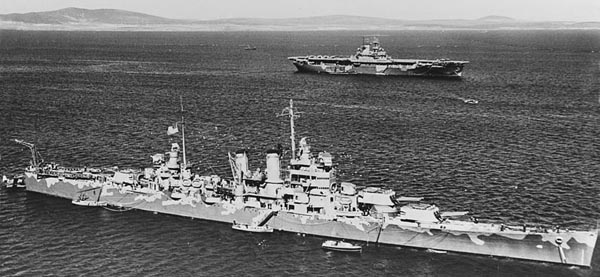
USS Wichita in Scapa Flow, April 1942
On 12 May, Wichita relieved Tuscaloosa off the Denmark Strait, later escorting the Murmansk-bound convoy PQ 16/QP 12. On 29 May she was in Scapa Flow, hosting King George VI on 7 June. She left Scapa on 12 June for Hvalfjörður, relieving HMS Cumberland on patrol in the Denmark Strait, where she spotted and fired on (but missed) two Focke-Wulf Fw 200 Condors patrol planes of the Luftwaffe.
At the end of June, she was at Seidisfjord, meeting Tuscaloosa and three destroyers to escort PQ 17, also escorted by HMS Duke of York. However, KMS Tirpitz escorted by three heavy cruisers made a sortie, codenamed Rösselsprung, which became known through Swedish intelligence and the admiralty fatefully ordered the convoy to disperse while the Germans aborted the operation. The scattered convoy fell to U-Boats and aviation, losing 21 of the 34 ships. Both Wichita and Tuscaloosa would also fire at Fw 200s, but again, missed.
In late July, USS Wichita was in drydock at Rosyth in Scotland. This included fixing shaft vibration she was suffering. On 9 August, the ship went out for sea trials, showing the problem was still there, and she departed for the United States, New York Navy Yard where she arrived on 22 August, drydocked until 5 September 1942. She then trained in the Chesapeake Bay, Virginia Capes, and Casco Bay (Maine).
Operation Torch (Nov. 1942)

Duelling with Jean Bart at Casablanca
In October, Wichita joined Task Group 34.1 (Rear Admiral H. Kent Hewitt, USS Augusta) also including USS Massachusetts and her old “sea pal”, USS Tuscaloosa. This force was to provide cover fire for Operation Torch, the invasion of Vichy-held French North Africa. USS Wichita on this occasion was part of the Battle of Casablanca, and took part in a gunnery duel that started in the morning of 8 November, trying to silence the coastal artillery at El Hank, tracking and sinking French submarines, and even duelling with the incomplete battleship Jean Bart at anchor in the harbor.
The latter had one turret operational and with it, fired on the US Task Force. Wichita and Tuscaloosa silenced El Hank forts, and ruined submarine pens in the harbor while USS Massachusetts took care of Jean Bart, but they soon had to deal with the cruiser Primauguet. The Vichy French launched two attacks, the first being with destroyers. Both Wichita and Tuscaloosa claimed serious hits on the destroyer Milan, which ran aground. The second attack was repelled, and again, both cruisers claimed the destroyer Fougueux and Frondeur.
Wichita, Tuscaloosa, and Massachusetts afterward engaged Jean Bart, and by 11:28, USS Wichita was hit by a 194 mm (7.6 in) shell from El Hank, a fortification that was believed to have been silenced. The hit cost fourteen men and captain Hewitt broke off before returning at 13:12, to combine fire on French ships trying to exit the harbor. Wichita and Tuscaloosa engaged on this occasion the cruisers Primauguet and Gloire while El Hank redoubled its fire, forcing both US cruisers to retreat after 15:00. As far as Wichita was concerned, the battle was over and she spent the next weeks patrolling between Casablanca and Fedhala and she returned to New York for repairs on 19 November.
Pacific theater
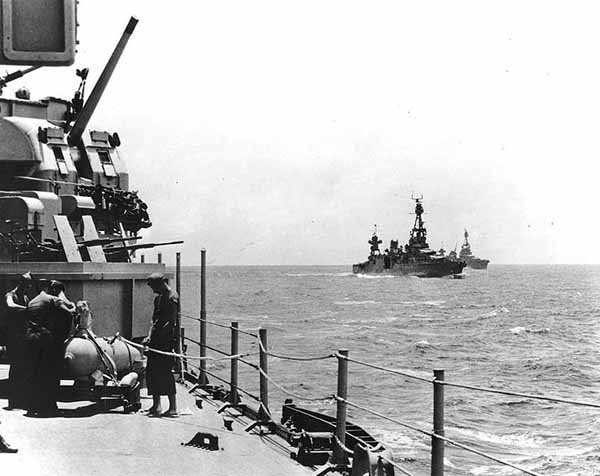
USS Louisville and Chicago and other ships off Rennell Island as seen from USS Wichita, on their way in the Pacific, 29 January 1943
Despite her accomplishments in the Atlantic, the situation in the Pacific was bad enough that the admiralty chose to send the cruiser to Task Force 18 (Rear Admiral Giffen), straight to Guadalcanal. There, she joined up with the heavy cruisers USS Louisville and Chicago, light cruisers USS Montpelier, Cleveland, and Columbia, and the escort carriers Chenango and Suwannee plus eight destroyers.
Night Battle 29-30 January 1943 off Rennell Island:
As Japanese submarines has been signalled by Allied intelligence the force was spread and organised for anti-submarine defense in two columns 2,500 yards apart. Wichita led a column with Chicago, Louisville, and six destroyers forming a 2-mile semicircle ahead. However, an attack came from Japanese torpedo bombers. The Battle of Rennell Island saw USS Chicago hit by airborne torpedoes and sinking. USS Wichita had more luck. She was hit only by one, which was a dud. She next steamed to Efate (New Hebrides) for maintenance and training and on 7 April sailed for Pearl Harbor.
Operations in Kiska and Attu
After taking onboard supplies she sailed to Adak, Alaska under Giffen’s command, in TF 52.10. By May, USS Wichita covered the landings in the Aleutian Islands, as the flagship of the Northern Force, with USS Louisville and San Francisco. On 6 July she shelled Japanese positions at Kiska and by July the Japanese started to evacuate. On 19 July she was joined by the USS New Mexico, Idaho, and Mississippi for another three days of preparation on Kiska. During this time, early radar caused glitches, leading to the infamous “Battle of the Pips”, where all the ships present firing a thousand rounds on an empty sea, before confirmation by a plane there was nothing there. Meanwhile, the Japanese evacuated the island and when the landing came, there was no fighting.
Marshall invasion (January 1944)
Wichita was back in Hawaii for exercises until the end of the year and on 16 January 1944, she was assigned to the Force gathered to invade the Marshall Islands. This time she was part of Task Group 58.3 (Rear Admiral Frederick C. Sherman) comprising the USS Bunker Hill, the cruisers USS Cowpens and Monterey, the BBs North Carolina, Massachusetts, Alabama, and South Dakota while Wichita, rearmed in between with her full complement of Bofors and Oerlikon guns, was to provide AA support. The carriers launched air strikes on Kwajalein and Eniwetok in February.
Pacific operations Truk, Saipan, Guam
Wichita sailed to Majuro, transferred to TF 58.2, sailing for Operation Hailstone, a major air raid on the IJN base at Truk, but before it was launched, on the night of 16 February, USS Intrepid was attacked by Japanese bombers and badly damaged. TF 58.2.4 was detached to escort Intrepid out of harm, and they were in Majuro on 20 February, then Hawaii. On March, 9, USS Wichita became the flagship of Cruiser Division 6, which departed Hawaii for Majuro, screening the Fast Carrier Task Force raiding Yap, Woleai, and the Palau islands. Wichita also covered a raid on Hollandia (New Guinea) on the 13–22 April and Truk until the end of April, shelling Japanese targets on Satawan Island and Nomol (Caroline).

Wichita underway in the Pacific, in May 1944
On 4 May 1944, USS Wichita was back to Majuro for supply, rest, and training. In June she was sent to Kwajalein for an operation against the Mariana Islands with TF 53.10.8. On 13 June she covered landings at Saipan, then Guam and Saipan again, before being assigned to Task Group 58.7, west of the Marianas to try to intercept a large Japanese carrier force, which became the Battle of the Philippine Sea. Wichita’s AA screen claimed two Nakajima B5Ns, and she was detached to escort troop transports and escort carriers off Saipan, a duty she maintained until early July before she later joined TU 53.18.1 bombarding Guam.
On 10 August she escorted a fleet to Eniwetok and later joined TG 38.1., escorting the fast carrier task group to attack the Carolines, the Philippines, the Dutch East Indies, Palau, and Morotai until mid-September. At 07:34, 22 September, USS Wichita was caught in an air attack, and downed two bombers, damaging others and providing AA cover during raids on Cebu, Negros, and Coron.
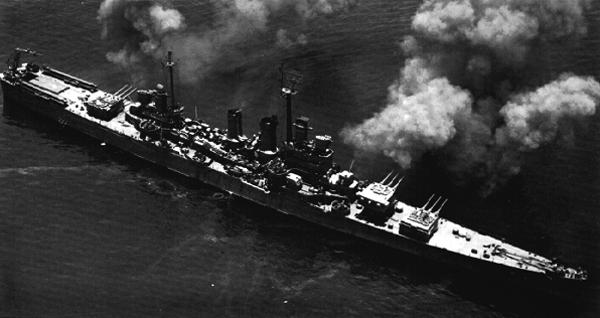
USS Wichita firing a broadside, 1944
Operations off the Philippines
USS Wichita raided Okinawa on 10 October and later did the same to Aparri and Formosa, paving the way for the US arrival in the Philippines. On 13 October 1944 her task force was attacked by Japanese bombers, which nearly sank HMAS Canberra, and she was towed to safety by USS Wichita which later protected the equally badly damaged USS Houston. By 21 October, USS Wichita was off Luzon with Task Force 34 (Vice Admiral Willis A. Lee), and soon engaged in the largest naval battle of WW2.
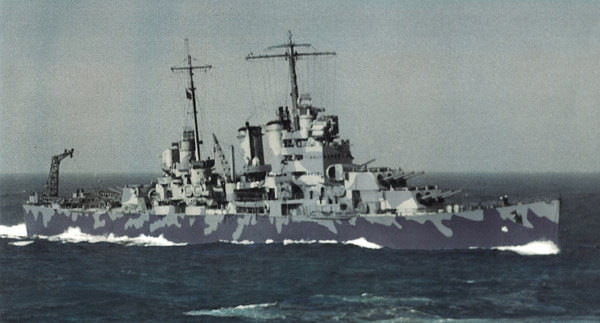
Wichita in 1942 – Colorized
Battle of Leyte Gulf
Wichita took part in the Battle of Leyte Gulf from 23-25 October. She covered the Fast Carrier Strike Force north, pursuing Jisaburō Ozawa’s decoy fleet of empty carriers. USS Wichita covered the US carriers which sank the Japanese carriers and later, USS Wichita and three cruisers sank the light carrier Chiyoda, along with her escort, the destroyer Hatsuzuki. She rained down AP shells in this engagement, with 148 rounds expended on Chiyoda, and 173 against Hatsuzuki. She later screened for the carriers off Samar. On 28 October, she covered the landings on Leyte, fending off a massive Japanese airstrike over the course of two days.
On 31 October, Wichita sailed to Ulithi, reaching the island on 2 November for supplies and a well-deserved rest. She would return to Leyte until mid-November, but her worn-out engines showed their limits as severe vibrations in the No. 4 engine led to a broken propeller shaft, so she sailed on 18 November for San Pedro, California. She reached her destination on 15 December and was repaired at Terminal Island NY. On 8 February 1945 she left, made a shakedown cruise, and after some extra training was assigned for a new task in late February, reaching Pearl Harbor before joining Ulithi.
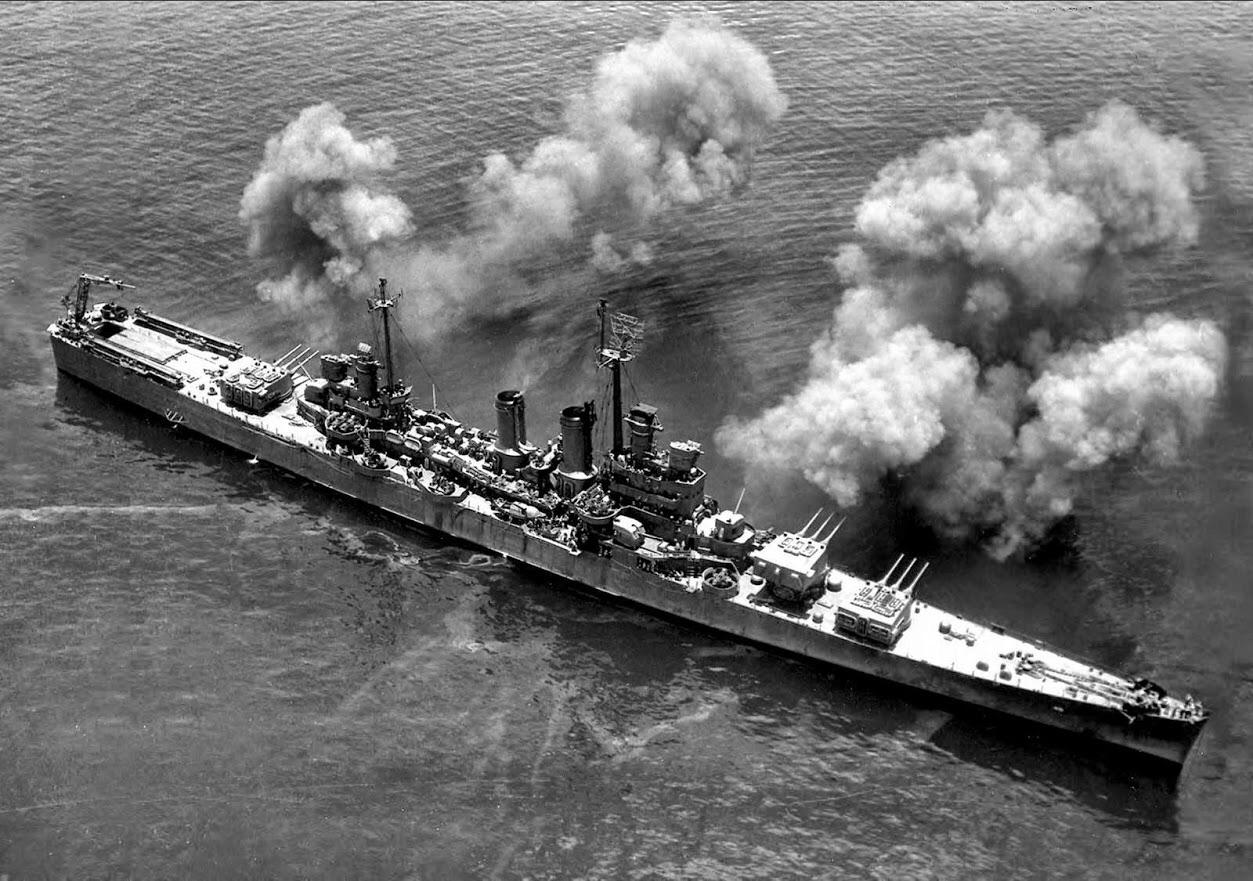
USS Wichita all guns blazing at Okinawa
Invasion of Okinawa
USS Wichita joined Task Force 54, the force planned for the invasion of Okinawa, and more precisely she was tasked to protect TFU 54.2.3, minesweepers operating in the waters of Okinawa from 25 March. A day after she shelled Japanese positions from 13:50 to 16:30, she was attacked by aircraft, claiming one. Her shelling missions went on until the 28th of March, retiring shortly to Kerama Retto for supplies, and later covering underwater demolition teams clearing the beach of obstacles. She also targeted the sea wall to create a breach.
On 1 April troops landed under Wichita’s close support gunfire, leaving around midday to replenish ammunition before returning, using her guns to cover US minesweepers. She then joined Task Group 51.19, preparing to shell Tsugen Shima with Tuscaloosa, Maryland, and Arkansas. However, the operation was cancelled because of a Japanese air attack. Wichita instead turned her guns against the shore batteries at Chiyama Shima. On 6 April, an A6M Zero Kamikaze targeted Wichita, and her anti-aircraft gunners soon hit the Zero’s tail which dropped its 500-pound (230 kg) bomb only 50 feet (15 m) from the hull, while its wing clipped the deck before crashing. Eleven men were wounded. Wichita was detached later to silence a battery at Nakagusuku Bay and went on bombarding Japanese defenses until departing on 10 April for supplies.
On 27 April, the cruiser took a hit (a light shell) in her fuel oil tank below the waterline but was temporarily repaired before departing for more repairs at Kerama Retto, on 29–30 April. On 12 May, while still covering the landings, she was damaged by friendly fire, a 5-inch round damaging her port aircraft catapult and AA director. She was refitted at Leyte and was back for more operations in June and July with TF 2. On 15 August, her crew learned the war was over and by the end of it all, she had won 13 battle stars.
Post-War service

Nagasaki, September 1945
Wichita was part of the occupying force of Japan and was by September in Nagasaki with TG 55.7, one of the first large US warships to enter Japanese waters. She was the flagship of a small force comprising destroyer escorts, minesweepers, and the hospital ship Haven. By late September she was in Sasebo before heading to Nagasaki. She then returned to Sasebo once more when she was hit by a severe typhoon. Later her crew inspected Japanese ships present and harbor installations.
On 5 November, the cruiser took part in Operation Magic Carpet, the repatriation of American military personnel after the war. In this, she made her first trip from Tokyo to San Francisco, which she reached on 24 November 1945. She entered drydock at Mare Island, until 1 December, and she resumed the repatriation trips from Pearl Harbor to the Marianas, Saipan, and back to San Francisco. The next year she reached Philadelphia via the Panama Canal on 14 February and was assigned to the Sixteenth Fleet in reserve by July 1946, before being finally decommissioned on 3 February 1947 at Philadelphia. Although there were discussions to convert her into a guided-missile cruiser, in March 1959 she was officially stricken and sold on 14 August for scrap.


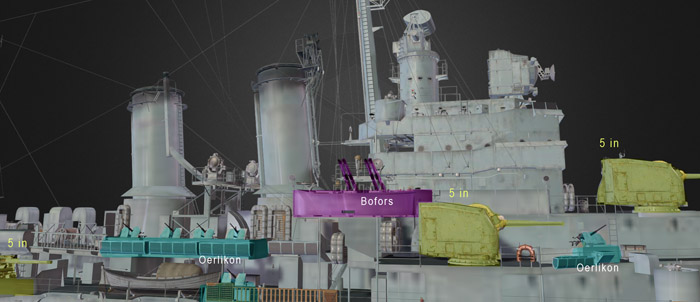
 Latest Facebook Entry -
Latest Facebook Entry -  X(Tweeter) Naval Encyclopedia's deck archive
X(Tweeter) Naval Encyclopedia's deck archive Instagram (@navalencyc)
Instagram (@navalencyc)





 French Navy
French Navy Royal Navy
Royal Navy Russian Navy
Russian Navy Armada Espanola
Armada Espanola Austrian Navy
Austrian Navy K.u.K. Kriegsmarine
K.u.K. Kriegsmarine Dansk Marine
Dansk Marine Nautiko Hellenon
Nautiko Hellenon Koninklije Marine 1870
Koninklije Marine 1870 Marinha do Brasil
Marinha do Brasil Osmanlı Donanması
Osmanlı Donanması Marina Do Peru
Marina Do Peru Marinha do Portugal
Marinha do Portugal Regia Marina 1870
Regia Marina 1870 Nihhon Kaigun 1870
Nihhon Kaigun 1870 Preußische Marine 1870
Preußische Marine 1870 Russkiy Flot 1870
Russkiy Flot 1870 Svenska marinen
Svenska marinen Søværnet
Søværnet Union Navy
Union Navy Confederate Navy
Confederate Navy Armada de Argentina
Armada de Argentina Imperial Chinese Navy
Imperial Chinese Navy Marinha do Portugal
Marinha do Portugal Mexico
Mexico Kaiserliche Marine
Kaiserliche Marine 1898 US Navy
1898 US Navy Sovietskiy Flot
Sovietskiy Flot Royal Canadian Navy
Royal Canadian Navy Royal Australian Navy
Royal Australian Navy RNZN Fleet
RNZN Fleet Chinese Navy 1937
Chinese Navy 1937 Kriegsmarine
Kriegsmarine Chilean Navy
Chilean Navy Danish Navy
Danish Navy Finnish Navy
Finnish Navy Hellenic Navy
Hellenic Navy Polish Navy
Polish Navy Romanian Navy
Romanian Navy Turkish Navy
Turkish Navy Royal Yugoslav Navy
Royal Yugoslav Navy Royal Thai Navy
Royal Thai Navy Minor Navies
Minor Navies Albania
Albania Austria
Austria Belgium
Belgium Columbia
Columbia Costa Rica
Costa Rica Cuba
Cuba Czechoslovakia
Czechoslovakia Dominican Republic
Dominican Republic Haiti
Haiti Hungary
Hungary Honduras
Honduras Estonia
Estonia Iceland
Iceland Eire
Eire Equador
Equador Iran
Iran Iraq
Iraq Latvia
Latvia Liberia
Liberia Lithuania
Lithuania Mandchukuo
Mandchukuo Morocco
Morocco Nicaragua
Nicaragua Persia
Persia San Salvador
San Salvador Sarawak
Sarawak Uruguay
Uruguay Venezuela
Venezuela Zanzibar
Zanzibar Warsaw Pact Navies
Warsaw Pact Navies Bulgaria
Bulgaria Hungary
Hungary

 Bundesmarine
Bundesmarine Dutch Navy
Dutch Navy Hellenic Navy
Hellenic Navy Marina Militare
Marina Militare Yugoslav Navy
Yugoslav Navy Chinese Navy
Chinese Navy Indian Navy
Indian Navy Indonesian Navy
Indonesian Navy JMSDF
JMSDF North Korean Navy
North Korean Navy Pakistani Navy
Pakistani Navy Philippines Navy
Philippines Navy ROKN
ROKN Rep. of Singapore Navy
Rep. of Singapore Navy Taiwanese Navy
Taiwanese Navy IDF Navy
IDF Navy Saudi Navy
Saudi Navy Royal New Zealand Navy
Royal New Zealand Navy Egyptian Navy
Egyptian Navy South African Navy
South African Navy






























 Ukrainian Navy
Ukrainian Navy dbodesign
dbodesign
Trying to find my father’s service records on the US S Witchita…Harold F. Tibets. Boston. Massachusetts
Hi Michael. Does not have crew’s registers, but perhaps better luck on this: https://www.history.navy.mil/research/archives/resources-for-researchers/research-guide-crew-lists.html
Best,
david